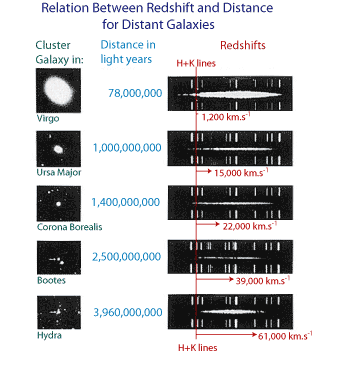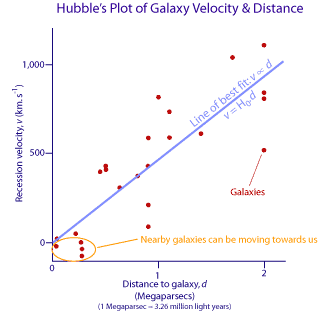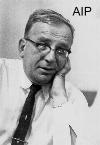Edwin Hubble & the Expanding Universe
Edwin Hubble (1889 - 1953)

Trained initially as a lawyer, Edwin Hubble moved to astronomy in 1914, working at the famous Yerkes Observatory near Chicago. He went on to have a profound influence on our understanding of the Universe. Using the largest telescope of his time, the 100 inch Hooker telescope on Mount Wilson in California, he helped resolve one of the great debates in early twentieth century astronomy.
Island Universes
One of the unsolved problems in early twentieth century astronomy was the question of what were nebulae? These gaseous, fuzzy clouds were thought by some astronomers to be embryonic solar systems forming while others thought that they were "island universe" like our own Milky Way galaxy. The advent of spectroscopy and photography in that late nineteenth century when used on the latest generation of large reflecting telescopes in the early twentieth century provided astronomers with the tools to study these objects.
Hubble used the 100 inch Hooker Telescope on Mount Wilson, then the largest telescope in the world, to study the Andromeda Nebula, M 31. In 1923 he identified some of the stars within it as Cepheid variables. These are periodic variable stars, that is stars that vary their brightness in a regular way. Earlier, in 1908 Henrietta Swan Leavitt, working at the Harvard College Observatory discovered that Cepheid variables in fact obey a period-luminosity relationship; the longer the period of a Cepheid, the more intrinsically luminous it is. This allowed Hubble to observe the Cepheids over time and measure their varying brightnesses to determine their periods. He could then apply the period-luminosity relationship to calculate the distance to the stars and hence the distance to the Andromeda Nebula that they were in. By 1924 Hubble had calculated that the distance to the Andromeda Nebula was 900,000 light years.
Supporting evidence came from the work of Vesto Slipher at the Lowell Observatory in Arizona. He had started measuring the Doppler shift of spectral lines from spiral nebulae in 1912. By 1925 he had shown that most exhibited redshifts in their spectral lines. He interpreted this as meaning that they were in fact moving away relative to us so their spectrum was shifted to longer (ie redder) wavelengths). Whilst he calculated that the Andromeda spiral was moving towards us at 300 km.s-1 he soon found others moving away at 1,100 km.s-1. These speeds exceeded that of any known star in the Milky Way.
Taken together the evidence eventually convinced astronomers that "spiral "nebulae" such as Andromeda were in fact separate "island universes" of billions of stars like our own Milky Way but more distant. We now call these galaxies instead of island universes.
The Expanding Universe & Hubble's law
Hubble, aided by Milton Humason extended the work of Slipher by using the larger Hooker telescope. He took long exposures of the spectra of faint galaxies. By measuring the amount of shift of specific spectral lines relative to those produced by reference arc lamps in the spectrograph he was able to calculate values for the galaxy velocities. A few nearby galaxies had velocities that meant they were moving towards our own Milky Way, that is their lines were blueshifted but most exhibited redshift and hence had recession velocities. The majority of galaxies therefore appeared to be moving away from our own galaxy. Hubble found that that those with a smaller image in a photograph had higher redshifts. This is shown in the diagram below that shows the images and spectra of some of the galaxies he observed.

He inferred that galaxies were similar to each other in size so those that appeared smaller must be further away. By plotting the velocity of the galaxies against their distance he came across an interesting relationship. This is now known as Hubble's law and is shown in the following plot.

If you study the above plot you will see that the more distant a galaxy is, on average, the faster it is receding from us. In fact Hubble realised he could fit a linear relationship to his data, as shown by the pale blue line of best fit. The slope of this line is a constant and is now known as the Hubble constant, H0. This relationship is expressed mathematically as:
so: v = H0d (2.2)
where H0 is Hubble's constant, v is the recession velocity and d is the distance.
Hubble's velocity-distance relationship, published in 1929, suggests that once we look beyond the gravitational effects of close galaxies within the local group, galaxies are moving away from one another. Not only are they moving away but the more distant galaxies appear to be moving away faster than closer ones. This then suggests that the Universe is expanding and indeed this is now the most widely-accepted interpretation of the data. The other key point arising from the relation is that if we go back in time galaxies must have been closer together, space was smaller. If you extrapolate back far enough the Universe must have been concentrated at a point in space.
If we assume that H0 provides us with a value for the current rate of expansion then its inverse, that is 1/H0 tells us the Hubble time which is a measure of the age of a universe expanding at a constant rate. Hubble calculated a value for H0 of about 500 km. s-1. Mpc-1. (1 Mpc-1 is 1 megaparsec or about 3.26 million light years. Astronomers use the parsec as the unit of distance measure rather than the light year. Details about the parsec can be found in the Year 12 Astrophysics topic). This value results in an age of the Universe of 2 × 109 years, that is 2 billion years.
Even in Hubble's day this age proved problematic as it clashed with radiometric dating values for the age of the Earth that ranged from 3 to 5 billion years and other evidence on the age of stars. Obviously this posed a dilemma - the Universe could not be younger than the stars or planets it contained! The problem was eventually resolved in the 1950s when the recalibration of the Cepheid period-luminosity relationship provided an age for the Universe in the range of 10-20 billion years.
Even today astronomers spend a lot of time trying to determine a more precise and accurate value for H0 and thus also an age for the Universe. The age actually also depends on what model is assumed for the geometry of the Universe; flat, open or closed. Recent projects involve a range of methods and do not just rely on observations of Cepheids to calibrate their data. Estimates based on observations of the cosmic microwave background radiation (CMBR) by the WMAP probe and other CMBR experiments currently suggest an age of 13.7 billion years ± 1% based on H0 = 71 km. s-1. Mpc-1 +4/-3. This agrees closely with the value determined by the Hubble Key Project team that used the Hubble Space Telescope to observe Cepheids in galaxies and calibrated their values with other techniques. They obtained a value of H0 = 70 km. s-1. Mpc-1 ± 10%
George Gamow (1904 - 1968)

George Gamow, a Ukrainian-born, US-based physicist and former student of Friedmann's, made his mark early by applying quantum theory to explain how alpha particles can be ejected from nuclei in alpha decay. Moving from the USSR in 1931 he settled in the US and continued his work on stellar evolution and beta decay. He was particularly interested in trying to solve the problem about the origin of the elements.
Hans Bethe had already shown in the 1930s how helium could be synthesised inside stars through fusion of hydrogen nuclei. He had also explained how protons and neutrons added to carbon nuclei could form heavier elements. Gamow had realised from Hubble's work that the early Universe must have been much smaller, hotter and denser than it is now. In the late 1940s with his students Ralph Alpher and Robert Herman he calculated that helium could form from the fusion of protons (that is, hydrogen nuclei) and neutrons. This nucleosynthesis would cease once the available neutrons were used up and the Universe had expanded and cooled sufficiently. They also realised that the Universe should be filled with background microwave radiation, the remnant of the original big bang now cooled to about 50 kelvin. This radiation would have the spectral characteristics of a blackbody.
Gamow's theory of the nucleosynthesis of primordial helium accounted for the observed abundance of helium compared with hydrogen in the Universe whereas stellar nucleosynthesis could not. His prediction of remnant radiation was neglected by others until the 1960s but was to provide the key evidence in support of the big bang model for the Universe.

